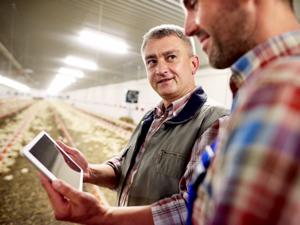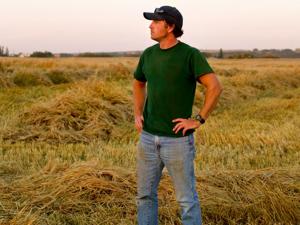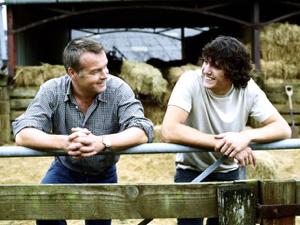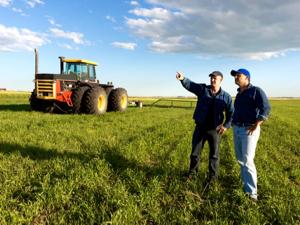Carleton University’s Samah Sabra shares how she helps other mid-career professionals actually acquire the new skills they need

Learning never stops on the farm. There’s always something new to wrap your head around, whether it’s a business or management strategy, human resources, marketing tools, production techniques, farm equipment technology, on-farm food safety and traceability protocols — the list is endless.
Indeed, the learning goes on even when you’re not aware of it. It happens in the tractor, in the farm office, round the kitchen table, at your accountant’s or your lawyer’s office, at a conference, via a webinar, or just talking to a neighbour.
But some skills demand a programmed approach. You just aren’t going to get as good a grasp of some topics or make good decisions if you learn one fact at a time instead of understanding the entire landscape. And there are different times in your farming life when you will need new skills.
As well, some individuals need a programmed approach, maybe because they’ve just graduated and now they need to start acquiring the skills they’ll need to manage the farm. Or because the farm is at the point where, for instance, it really needs someone to tackle HR issues and to understand all the details behind wages, filing requirements, insurance, etc.
There’s lots to be said for formal and informal learning, but developing a learning plan is sometimes necessary to help focus the learning we really need to do, rather than wandering off on tangents that may be interesting in themselves, but that do little to move our own personal development or the farm’s vision forward.
Fortunately, there’s a proven approach. Start by using adult learning principles. They’re as relevant on the farm as they are at a university or college.
Samah Sabra is a professional development officer with the Office of Quality Initiatives at Carleton University. She works with students, staff and faculty to support them in identifying their learning goals and develop learning plans.
Two essentials are developing a sense not only of the importance of lifelong learning but also of the transferability of the skills that you already have. As well, it’s important to identify goals and to break them into different components, and to figure out how to achieve them and how to adjust your plan as you go along.
To do that, Sabra shares her seven essential elements for developing an effective learning plan.
1. Set learning priorities

When helping students and staff develop learning plans, Sabra begins with something called backwards design. “The first step is always thinking about your needs in relation to a particular goal or outcome and start with ‘what’s the end goal? Where do I want to get to?’ Then you work backwards from there,” she says.
“You might start with a large goal and then break it down into the different component parts, and for each of those, you’d have measures of how do I know that I’ve achieved this thing that I want to achieve.”
2. A coach with the right questions

Sabra is a big believer in coaching, especially when a person is trying to develop a plan for learning. Having someone you trust to help you think through some of the questions you need to ask is vital.
“Coaching is really about having someone who can ask you the kinds of questions that can help you get started to develop a plan… they don’t necessarily need to know about the particular area you’re working on,” says Sabra.
There are also a growing number of personal and professional coaches online, some of whom will work with individuals remotely via phone or Skype. You may also have trusted people in your life who would make a good coach, like a former teacher who knows your personality and aptitude for learning.
The key is to explore the right questions in an open-ended way.
As an example, in talking about achieving a certain goal or step, a good coach, instead of asking “what are the three things you can do right now to help you get there?” might rather ask “what’s the first step you can take to help you start getting there?” or “what’s the smallest change you can make right now that will help you achieve the most?”
These questions get the person thinking for themselves rather than limiting them to a list of three options. Indeed, they may find five!
“With teacher training now, there is a focus on using this kind of Socratic or coaching method of asking questions rather than providing answers,” says Sabra. “Teachers aren’t there to just give information because anyone can find that anywhere. The teacher is there to help a person understand his or herself as a learner and how to develop those lifelong skills that will transfer no matter where they go.”
That could lead you to realize you need somebody who has substantive knowledge in a particular area — more of a mentor — and to reach out to that person. “Or you might join an online group where people are sharing their experiences, and you’re going to comb the internet for all sorts of advice, tips and life hacks because you find those really motivational,” says Sabra.
3. Follow the sign posts (but don’t be afraid of detours)

There are different ways to measure achievements on the learning plan. Really, though, it’s about having sign posts for yourself so you can tell when you are taking a detour and figure out a way to get back on track.
Detours aren’t necessarily bad, because a good learning plan should allow the flexibility for you to decide that the way you intended to reach your goal may not be realistic or needs a different approach.
“You might realize that you thought you would reach a goal in a particular way and that’s not going to work for you because you’re not motivated to do this particular thing,” says Sabra. “Now you need to find a work-around, a new way to find that motivation, a new way to achieve it. So, it’s about ‘what’s the end goal and what are my sign posts that allow me to know that I’ve stayed on track?’”
4. Learn at the right pace for you

Interestingly, Sabra often uses the metaphor of a gardener when she speaks about teaching, learning and development, to illustrate the importance of learning at the right pace.
“How do you identify the things that a seed needs to grow into a plant and how do you offer them, but then also get out of the plant’s way?” says Sabra. “If someone is constantly overseeing and over-managing the plant, chances are it’s not going to thrive very well because they’re overwatering it. The same things apply to learning, knowing when to rest, knowing when to give yourself a break, knowing when you might be over-managing the learning rather than giving yourself the opportunity to learn from an experience, reflect on it, identify what it is that you’ve learned and what the next steps will be where you can put that learning into practice.”
It’s important to monitor learning progress but not to panic if it seems to be taking longer than anticipated. The temptation is often strong to believe we’re doing something wrong, not working hard enough or just not capable of learning something if we’re not making as much progress as we thought we would, but that’s the time to step back and start breaking things down into smaller chunks.
Using the analogy of the plant again, Sabra says, “If the plant’s not growing as fast as you wanted, instead of panicking and saying I must be doing something wrong. Chunk it out. Think about what you’ve tried and haven’t tried. Maybe you’ve worked with watering, but have you tried adjusting the plant’s position to get more sunlight, or is it next to another plant that might be overtaking it?”
5. Measure learning outcomes. Am I there yet?

For many people the challenge is knowing when they have truly learned what they set out to learn. When teachers and educators create learning outcomes they make them measurable and usually contain a verb or an action item that can act as a measurement of achievement (see sidebar).
“Ideally, we know that someone has really learned something when they’re able to teach it to someone else, that’s sort of the highest form,” says Sabra. “That means they have learned something in a way that’s mindful and learned it so well they can break it down and help somebody else understand how to get there.”
Sabra encourages journaling as a way to reflect on what has worked, not worked, and what people need to do differently. “Reflection is important for people in general, but if you’ve never spent time doing that kind of personal guided reflection, a starting point might be finding a person who can help guide you or find a book that can give you some good guiding questions for personal reflection.”
6. Ask for knowledge

Sooner or later it’s likely that a person will need a more experienced or knowledgeable mentor to show them how to do something or impart some knowledge. On a busy farm, how do they approach someone who is already doing a million different things to ask them to take time away from all that to share their knowledge, without feeling that they are being a nuisance?
“A farm is an organization much like a university is an organization and both create opportunites for people to develop,” says Sabra. “Passing on knowledge is a way of ensuring that the organization keeps going.”
Sabra offers an example that is often used at educational conferences. If you have one person who’s really good at drawing circles and everyone constantly goes to them for circle drawing, that person never develops the skills to learn how to draw a square because they’re always drawing everyone’s circles, but also nobody in the organization learns how to draw a circle. So, if something happens to that person, you’re suddenly stuck with nobody who can draw a circle.
“Sharing knowledge sometimes might take a little bit of time, but it is really good for the organization in the long term, and in terms of succession planning, it’s ensuring that the organization goes on,” says Sabra.
The other important thing about knowledge sharing is that as a person helps others learn a job or task that only he or she does, it can create some capacity for that person because now they have someone who can also do that task and help out.
As part of Carleton University’s in-house leadership development initiatives, Sabra challenges staff to frame things and think about the benefits of a particular course or program in relation to me, we and us.
“What is the benefit to me, the person who is doing the thing as an individual; the we, so thinking about the team that you might be a part of; and to us, which is the broader organization,” she says. “When we’re asking for help or support, if we are able to frame the kind of benefit that’s there in relation to ourselves, the person who’s supporting us but also the community and the organization, then we realize what’s at stake in helping develop others.”
7. Review along the way

“Having the learning plan written down and maybe shared with somebody gives you a new level of accountability for yourself,” says Sabra. “It gives you a way to correct when you’re going a bit off course. Give yourself a timeline when you will revisit what it is that you’re working on and see where you’re at.”
But don’t be too hard on yourself if you find not everything has gone exactly according to the plan.
“Maybe you realize that I didn’t do this because I realized that there’s this other thing that I need to accomplish first. I haven’t stuck with my plan, but I made my plan better by identifying this stepping point along the way,” says Sabra. “Finding that place for self-compassion can be really important when we’re learning.”
It’s important to veer away from asking questions like, “why didn’t this happen?” adds Sabra. Such questions can often lead to someone getting down in the dumps or discouraged. “Instead, ask those ‘what’ questions that allow you to identify specific things. What got in my way? When have I encountered this kind of barrier before and what worked for me then? How can I then leverage that to help me now?”
If you can find the right coach, he or she may be willing to help provide some honest feedback as you work through your learning plan, because there’s always room for some positive, constructive feedback to keep you on the right course, says Sabra.
“One of the traps that we fall into is that we don’t always let people know what they’ve done well and so sometimes you end up in a place where, when you’re trying to address the constructive feedback that you’ve been given, you accidently change something that you’ve been doing really well,” she says. “Letting people know what they’ve been doing well, what has worked well and where there’s room for growth and how they might grow are all equally important. A lot of people are uncomfortable getting the positive feedback but it is valuable and has an important role.”







